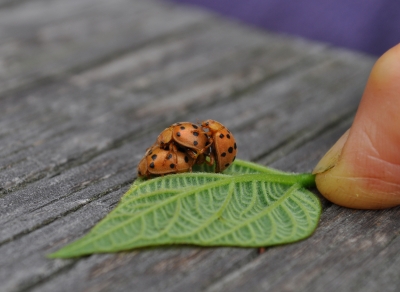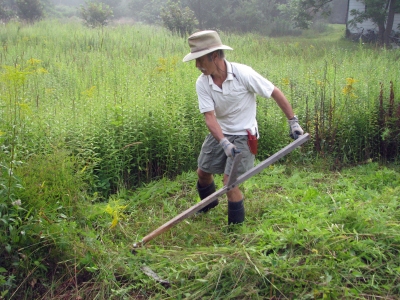Eerie White to Golden Flowers, with Some Fungi Helping Out
/3 Comments/in Design, Gardening, Soil/by Lee ReichWhite Indian pipes, mycorrhizae, and a golden flower
I do occasionally tear myself away from the farmden. So into the woods I went last Friday and as I was hiking along and glancing down at the trail, I came upon one of my favorite flowers. It’s a favorite not for its beauty but for what it hints at of goings-on beneath the soil surface.
The flower was indian pipes, Monotropa uniflora, an eerily white plant that looks like a upright tobacco pipe whose stem has been poked into the ground. Yes, it’s white. All white. You might rightly wonder how the plant synthesizes carbohydrates for energy and for structure. Photosynthesis, which makes carbohydrates, requires chlorophyll, which is green. Indian pipes don’t need chlorophyll because they get their carbohydrates from neighboring trees.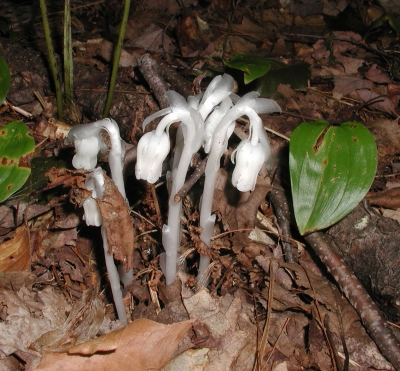
Join me while I go below ground. Stopping for a look at the roots of indian pipes, we see that they are infected with the fine threads of fungal hyphae. Now, if we follow the fine threads of the fungal hyphae out of the roots and through the soil, we eventually come to the roots of a nearby tree whose roots also are infected by one and the same fungus. A continuous connection exists from the tree to the fungus to the indian pipes.
The tree does have green leaves and, as with other plants, some of the products of its photosynthetic labors are channeled down to its its roots. Some of those products travel out the roots and into the fungal hyphae, and some of that is drawn out of the hyphae into the indian pipes for the latter’s sustenance and growth. Sounds like a one-sided relationship, a pretty good deal for the indian pipes. It is. The plant is a parasite, taking but offering nothing in return.
The relationship between the fungus and the tree, however, is symbiotic and called mycorrhizae (my-co-RYE-zay, which means fungus-root). Yes, the fungus sucks up some of the tree’s photosynthates, but in return it sucks up nutrients from the soil, then channels them back to the tree’s roots. The network of fungal hyphae in the soil is much more extensive than that of the roots, so, with fungal hyphae as “extenders,” the effective volume of soil “grazed” by roots is increased. Mycorrhizae are especially important for uptake of nutrients such as phosphorus, which roots (or their fungal extenders) must go out and find because it moves but little in the soil.
Myco . . . say what?
Wouldn’t mycorrhizae spur growth of garden plants? Yes. But look out your window; most of the plants you see are naturally mycorrhizal already. Still, deliberate inoculation might benefit young transplants. You can purchase inoculum, but the problem is that purchased inoculum often is not of fungal species best adapted to a particular location.
A better approach would be to keep your indigenous fungi happy. Limit tillage, which discombobulates the hyphae, grow a variety of plants, especially those that form mycorrhizal associations, and avoid pesticides. Also limit phosphorus fertilizers because they suppress mycorrhizae.
Another approach would be to grow your own mycorrhizal inoculant of local fungal species. Basically, you mix up a big batch of potting soil that has some indigenous soil in it and is not too high in nutrients. In this potting soil you grow a suitable host plant. (Not spinach, beets, or any plant in the cabbage family, none of which ever form mycorrhizae.) After the host plant dies at the end of the season, what’s left in the pot is indigenous fungal inoculum that can be added to a potting soil for growing seedlings. For more details, see http://rodaleinstitute.org/a-complete-how-to-on-farm-am-fungus-inoculum-production/. I use garden soil and compost in my potting mixes and assume there’s sufficient inoculum already present.
Grow Some Gold
As I rounded the bend at the back of my garden after my woodland hike, I came face to face with a flower I had planted temporarily back there, giant knapweed (Centaurea macrocephala), also known as Armenian basket flower, globe centaurea, and yellow hardhat. Plants with too many common names are usually suspect to me, and none of this plant’s names have a particularly nice ring to them — yet this plant is a showstopper.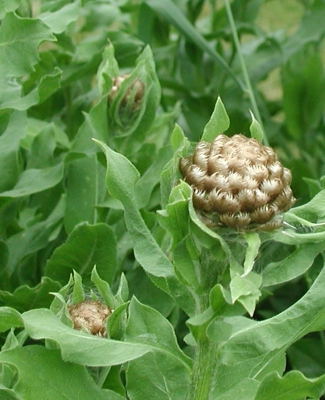
From the whorl of rather coarse leaves at the base of the plant rises a sturdy flower stalk. At almost 4 feet high, a big fat bud forms atop the stalk, a bud that looks like a globe artichoke that has been gilded. Nice enough even then, but a couple of weeks later — which is now — a bottlebrush of lemon yellow petals spills forth from the top of the bud.
Globe centaurea, the name most euphonious to my ears, tolerates heat and cold (USDA Hardiness Zones 3 to 8), and is relatively carefree. No need to prop the flower stalk up with a stake. The blossoms put on their show for about a month, not counting the gilded opening act, and hold up well as cut flowers, or can be dried.
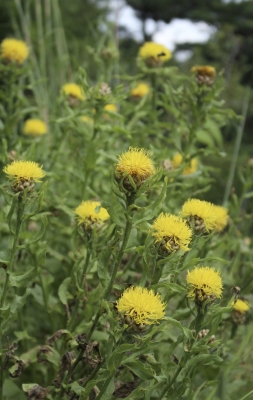 Globe centaurea deserves more attention over much of the country, except perhaps in the Pacific Northwest, where it’s considered invasive. I grew it years ago, and it disappeared. Nice to have it back.
Globe centaurea deserves more attention over much of the country, except perhaps in the Pacific Northwest, where it’s considered invasive. I grew it years ago, and it disappeared. Nice to have it back.
Plagues Come & Go, With Some Help, and Seattle-time
/10 Comments/in Fruit, Gardening, Pests/by Lee ReichMeet me in St. L . . . Seattle
Come hear me lecture on August 10, 2014 on “Luscious Landscaping, with Fruiting Trees, Shrubs, and Vines” at 1 pm in the Garden Room at Magnuson Park. For more information, go to http://www.brownpapertickets.com/event/755459.
Plague again; keep calm
Every year it seems some new plague is ready to attack plants. A few years ago, late blight of tomato moved to the fore. Emerald ash borer, threatening ash trees, was first found on our shores in 2002. (Figuratively; literally, the insect, native to Asia, was first noted in Michigan.) What’s next?
Perhaps a calmer outlook is called for. A decade or so garlic mustard seemed ready to take over our world. Not so, now, perhaps because it’s being crowded out by Japanese stilt grass, which itself seems now ready to take over our world. Garlic mustard is native over much of the northern hemisphere, except North America, and was introduced here around 1860 as a culinary herb. As for stilt grass, it hitchhiked here from China about a century ago, as packing material for porcelain. It’s deer-resistant, for what that’s worth.
Plant problems come and go. The best approach is to keep calm and, in some cases, plant something different, something plague resistant.
Bean Beetle Management
Green beans are a mainstay of my garden, of just about every garden. More than 20 years ago, Mexican bean beetles (a species of ladybug!) found my bean plants and have plagued them every year since.
The adults, with eight black spots over a red or yellow background, wake up late from winter sleep to lay eggs on bean leaves. I’ve come to despise the yellow, balled up spiny larvae that gorge on leaves and other plant parts.
Still, I have managed to grow good crops of beans over the years, not by killing the beetles or their larvae, but by growing a different plant. Sort of. Rather than grow pole beans, which reside in the garden all season long to provide a constant source of beetle food, I have been planting successive crops of bush beans. Bush bean plants tend to bear quickly and for about 3 weeks, then peter out, so a new planting in a new bed goes into the ground every 3 weeks from mid-May until late July.
Yield from a planting tapers off just as its resident beetle population is beginning a feeding frenzy. Then it’s time to pull up the plants, thoroughly clear the bed of leaves and old pods, and rush it all to the compost pile. Chopping the debris with a machete and burying it beneath straw and manure, and watering the pile, as needed, sends the temperature soaring, killing most of the beetles. Bean beetles are good fliers, so cooking the beetles in the compost pile doesn’t solve the problem, just keeps it under control.
Death to the beetles, with restraint
Something strange happened this year: As of this writing, only one beetle larvae has been seen. Last year I doused the bean plants a few times with one of two organic sprays, which gave good beetle control. It also gave me the confidence to try growing pole beans, as I did in my pre-Mexican bean beetle days. They got some bean beetles but we did harvest pole beans.
The sprays were Entrust and Azamax, both approved for organic agriculture. The active ingredient in Entrust is spinosad, a compound found in bacteria, Saccharopolyspora spinosa, that was isolated from soil collected inside an old rum still in the Virgin Islands. Although toxic to a range of insects, it is otherwise relatively benign. Still, the label requires waiting at least 3 days to harvest after spraying.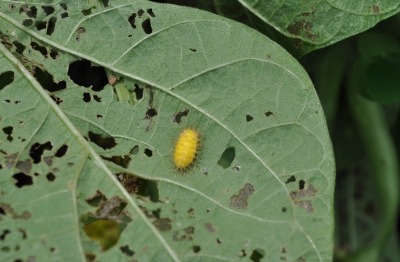
Azamax is an extract of the seed of the tropical neem tree, native to the Indian subcontinent. In that part of the world, this one tree has been used as human food, insect repellant, bird repellant, and an ingredient of soap. It degrades rapidly in soil or in water, and is harmless to earthworms, honeybees, and insect predators. Food crops can be harvested right after spraying Azamax.
Still, Azamax and Entrust are pesticides. Perhaps the bean beetle cycle has been broken here and sprays can be forgone in the future. I’ll keep calm. No sprays this year, yet.
SWD, go away
The same two organic sprays might be called upon for another pest, the spotted wing drosophila, unaffectionately known as SWD. Also an Asian import, this one has moved east since being first spotted in 2008 in California. It is hard to keep calm with this pest because it attacks blueberries, my favorite and heretofore my most reliable and abundant fruit crop. The pest is also fond of blackberries, raspberries, and — not that it matters to you or me, because we don’t eat them — honeysuckle berries.
 Again, there are management options. Because SWD seems to blow in from more southerly locations, a fine net could exclude them. Prompt refrigeration of harvested berries for 3 days kills larvae within. Thorough harvest of sound and unsound berries also keeps populations in check.
Again, there are management options. Because SWD seems to blow in from more southerly locations, a fine net could exclude them. Prompt refrigeration of harvested berries for 3 days kills larvae within. Thorough harvest of sound and unsound berries also keeps populations in check.
And then there’s Entrust and Azamax (or some other neem product), any of which I consider a last resort. I’m setting up traps to monitor if and when SWD arrives. (For information on monitoring, see http://www.fruit.cornell.edu/spottedwing/monitoring.html.) Till then, and after, I’ll try to remain calm. Om. Om. Ah-oh-om.
Farmden Health Club & Basil
/1 Comment/in Gardening, Tools, Vegetables/by Lee ReichRei-King, an Ancient Exercise?
Among the many benefits of gardening is the opportunity it offers for enjoyable, productive exercise in the great outdoors. And now we can add an exercise called rei-king to boot camp, pilates, zumba, kick boxing, cardiofunk, and other ways modern humans build and maintain sleek, fit bodies. Or so I told my wife, Deb.
As with some of those other exercise routines, equipment is needed, simple equipment in the case of rei-king. Basically, the equipment is a pole, perpendicular to and at the end of which is a length of wood or metal, attached in its middle to the pole. From the lower side of the length of wood or metal are teeth, each a couple of inches apart and a couple of inches long.
Now for the exercise. You lift the pole just enough to bring the head off the ground, reach forward, and pull it towards you. For balanced exercise, it’s advised to occasionally switch which arm is most forward.
Resistance is the way to build up muscle and endurance. That resistance comes in the form of friction from material lying on the ground. This time of year, that material might conveniently be mown long grass or hay.
And Sie-Thing
I sometimes practice rei-king; more often I choose another exercise that complements Deb’s rei-king. I practice sie-thing (pronounced “sigh-thing”).
Like rei-king, sie-thing entails using one piece of equipment, a sie. The sie also has a single pole, in this case with two handles attached, one at the upper end and one about halfway down. A metal weight is attached at the bottom of the sie. The metal is a couple of feet long, curved, and sharpened on its inside edge. Muscle tone and strength is created by putting the left hand on the upper handle, the right hand on the lower handle, flexing the spine to the right and then unwinding it to the left while trailing the metal weight just above ground level.
Again, sei-thing can be made more rigorous, in this case by passing the sharp metal through tall grass or meadow plants. The taller the plants, the denser the plants, and the older plants, the more the resistance.
A side benefit of all this sie-thing is that grass or meadow plants get mown during the exercise. The fallen material drops right in place, providing an opportunity — for me or, more usually, Deb — to then practice rei-king.
By the way, either exercise is most enjoyable early in the morning. At that time, plants are turgid so the sharpened metal of the sie pops plant cells as it is drawn along. And the fallen plants, best for rei-king after lying on the ground a day or two to wilt, cling together nicely when heavy with dew. The cool morning air is also conducive to exercise.
Basil for Winter?
Many years ago I grew the few varieties of basil that were available and then wrote about them. My conclusion, at the time, was that taste differences between the varieties were minor, so the choice of what to grow should perhaps be on the fun of saying their names, which put Genova Profumatissima, Syracusa, and Fino Verde Compatto at the top of the list. What fun to wave my arms and speak their names!
Or, a variety could be chosen for the size or color of its leaf, whether for decoration or culinary use. “Spicy Globe basil, planted close together, makes soft, green mounds resembling a miniature boxwood hedge,” I wrote. Now we have yet another decorative form: Bonsai Basil.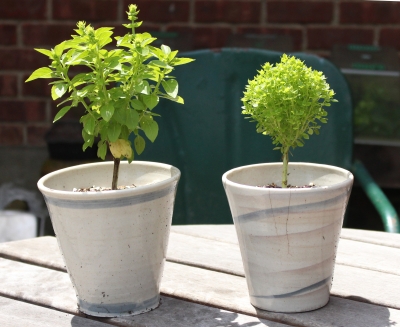
To create a bonsai basil, a variety such as Spicy Globe — perfect, with its diminutive, closely spaced leaves — is grafted onto a special rootstock. That rootstock is another variety of basil, one chosen, in perfect world, to impart to the grafted plant vigor, disease resistance, and hardiness. Periodically shearing such a plant keeps up appearances even as it provides basil for flavoring. Over time, the trunk even turn woody.
Even better, carry on the fun and the flavor through winter. Basil is perennial in the tropics but generally does not fare well in the cool, dry air, and relatively dark conditions of a northern home in winter. All of which calls out for a vigorous, disease-resistant, hardy plant. A grafted basil. Grafted basil, even more than grafted tomatoes, are very much the new kid on the (grafted) block.
A few weeks ago I was given a couple of grafted bonsai basil plants and I’m planning to grow them as perennials. It turns out that my plants are on a rootstock called Nufar which is resistant to fusarium disease. My soil doesn’t harbor basil fusarium disease, so that rootstock is of no benefit in that department. Perhaps it will help get the plant through the long, dark winter indoors anyway.
New rootstocks that could impart vigor and hardiness to help get a bonsai basil through winter — indoors, of course, around here — are on the horizon.
————————————————-
Ah, fusarium. Reminds me of last week’s patting myself on my back about my conquest of pea fusarium, which has plagued me for years. Well, between last week and this week, fusarium has again reared its ugly head and the vines have yellowed. I did get a decent crop, however. Looks like management rather than conquest will be the key to annual harvests of peas.



